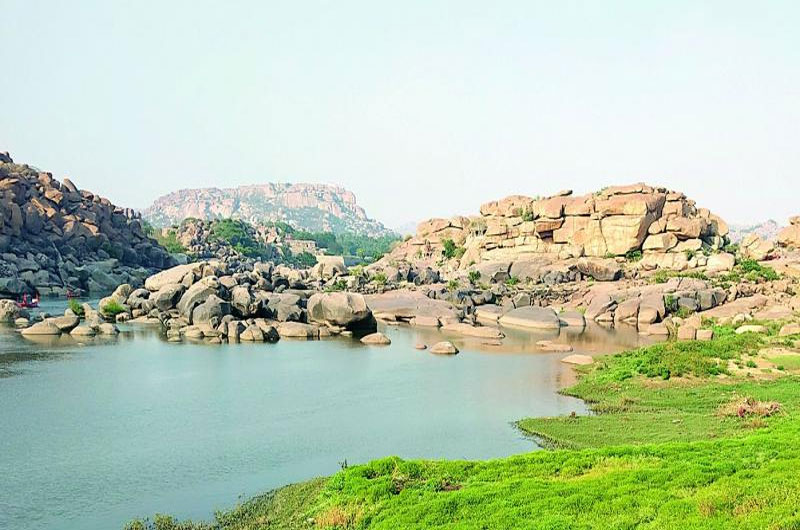
The Majestic Tungabhadra River: A Journey Through Time and Nature
The Tungabhadra River, an important tributary of the Krishna River, flows through the Indian states of Karnataka and Andhra Pradesh. Known for its historical significance, cultural heritage, and scenic beauty, the Tungabhadra River has been a lifeline for the regions it traverses. This detailed guide explores the Tungabhadra River, highlighting its tourism specialties, local attractions, history, ideal visiting periods, and practical travel tips.
Introduction
The Tungabhadra River is more than just a waterway; it is a symbol of the rich history and vibrant culture of southern India. Originating from the confluence of the Tunga and Bhadra rivers in Karnataka, the Tungabhadra River flows eastward, enriching the landscapes and lives along its course. This guide provides a comprehensive overview of the Tungabhadra River, making it a must-read for anyone planning to explore this enchanting region.
Geographic Location and Course
Origin and Path
- Origin: The Tungabhadra River originates at the confluence of the Tunga and Bhadra rivers near the town of Kudli in Karnataka.
- Course: It flows eastward, passing through the states of Karnataka and Andhra Pradesh before joining the Krishna River.
- Length: The river spans approximately 531 kilometers.
Ecological Significance
- Biodiversity: The river supports diverse ecosystems, including forests, wetlands, and agricultural lands, which are home to various species of flora and fauna.
- Economic Impact: The Tungabhadra River is crucial for irrigation, hydroelectric power generation, and supporting local economies through agriculture and fisheries.
Tourism Specialty
Scenic Beauty
- Picturesque Landscapes: The Tungabhadra River offers stunning views of rolling hills, lush green fields, and serene waters, making it a paradise for nature lovers and photographers.
- Waterfalls and Rapids: The river is dotted with several waterfalls and rapids, offering breathtaking vistas and opportunities for adventure activities.
Adventure and Activities
- Water Sports: The river is ideal for various water sports, including kayaking, canoeing, and fishing.
- Trekking: The surrounding hills and forests provide excellent trekking trails, offering panoramic views of the river and the landscape.
Cultural Experiences
- Festivals: Various cultural festivals and religious events are held along the river, showcasing the region’s vibrant traditions and heritage.
- Local Crafts: The riverine communities are known for their traditional crafts, including pottery, weaving, and metalwork, which visitors can explore and purchase.
Locality and Major Cities
Key Cities Along the Tungabhadra
- Hospet: A major town in Karnataka, Hospet is known for its proximity to the historical site of Hampi and the Tungabhadra Dam.
- Hampi: A UNESCO World Heritage Site, Hampi is renowned for its ancient temples, ruins, and stunning landscapes along the river.
- Kurnool: Located in Andhra Pradesh, Kurnool is a significant city with historical and cultural attractions, including the Konda Reddy Fort and Oravakallu Rock Garden.
Nearby Tourist Spots
- Hampi: Explore the ruins of the Vijayanagara Empire, including the Virupaksha Temple, Vithala Temple Complex, and the iconic Stone Chariot.
- Tungabhadra Dam: One of the largest dams in Karnataka, offering picturesque views, boating, and a beautiful garden.
- Mantralayam: A famous pilgrimage site in Andhra Pradesh, known for the Samadhi of Saint Raghavendra Swamy.
History of the Tungabhadra River
Ancient and Medieval Significance
- Historical References: The Tungabhadra River has been mentioned in ancient texts and records, highlighting its importance in the region’s history and culture.
- Vijayanagara Empire: The river played a crucial role during the Vijayanagara Empire, serving as a natural defense and supporting agriculture and trade.
Colonial and Modern History
- British Era: During British rule, the river was harnessed for irrigation and transportation, significantly impacting the local economy.
- Post-Independence: After India’s independence, the Tungabhadra Dam was constructed, providing water for irrigation, hydroelectric power, and drinking water, further enhancing the river’s importance.
Best Time to Visit
Ideal Seasons
- Winter (October to February): The weather is cool and pleasant, making it the best time to visit for outdoor activities and sightseeing.
- Monsoon (June to September): The river experiences increased flow during the monsoon season, offering lush green landscapes and a unique experience of the river in full spate. However, travel might be challenging due to heavy rains.
- Summer (March to May): While the weather can be hot and humid, early mornings and late evenings are still enjoyable for river activities.
Special Events
- Hampi Utsav: Celebrated in November, this cultural festival in Hampi features music, dance, and traditional performances, reflecting the region’s rich heritage.
- Rathotsava: Held at the Virupaksha Temple in Hampi, this chariot festival attracts thousands of devotees and offers a glimpse into the region’s religious traditions.
Nearby Restaurants and Hotels
Restaurants
- Mango Tree Restaurant: Located in Hampi, this riverside restaurant offers a variety of local and international dishes in a serene setting.
- Naivedyam Restaurant: Situated in Hospet, this vegetarian restaurant is known for its delicious South Indian cuisine and friendly ambiance.
- Hotel Kanishka: Located in Kurnool, this restaurant offers a range of Indian and Chinese dishes, providing a comfortable dining experience.
Hotels
- Hampi’s Boulders Resort: Nestled along the banks of the Tungabhadra River, this eco-resort offers luxurious cottages, stunning views, and various activities.
- Royal Orchid Central Kireeti, Hospet: A modern hotel with well-appointed rooms, excellent dining options, and proximity to Hampi and the Tungabhadra Dam.
- The Mourya Inn, Kurnool: A comfortable hotel offering well-furnished rooms, a restaurant, and easy access to the city’s attractions.
Conclusion
The Tungabhadra River, with its blend of natural beauty, cultural richness, and historical significance, offers a unique and enriching experience for travelers exploring southern India. From its scenic landscapes and vibrant festivals to its historical landmarks and modern attractions, the Tungabhadra River promises a memorable journey through one of India’s most captivating regions. Whether you are seeking adventure, cultural insights, or a tranquil escape, the Tungabhadra River has something to offer for every traveler.
